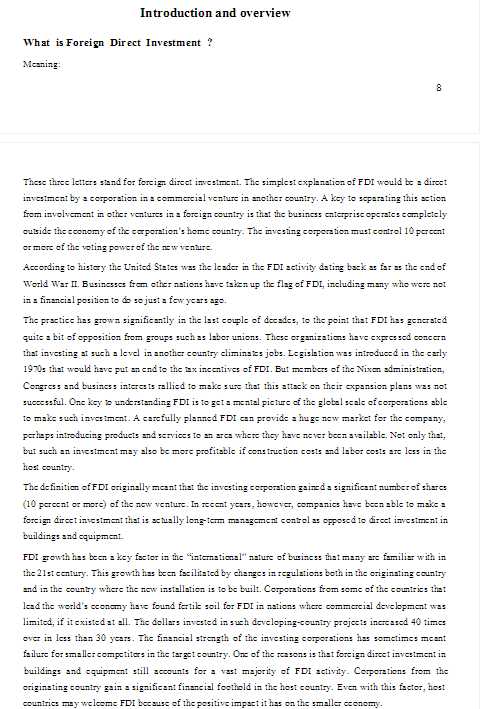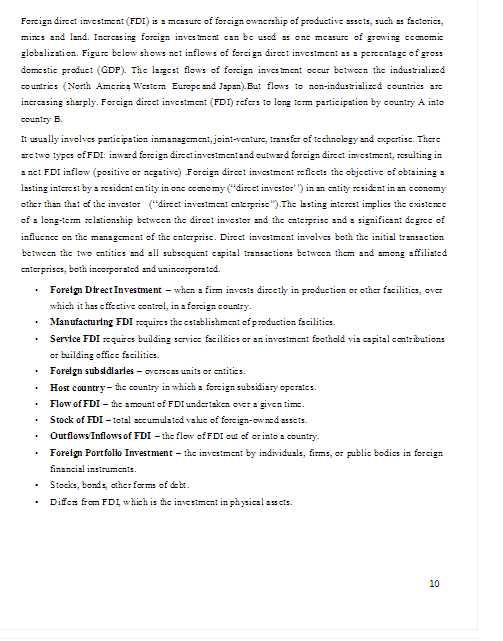|
#2
25th March 2017, 04:06 PM
| |||
| |||
| Re: Fdi mba
As you are looking for sample project based on Foreign Direct Investment (FDI), so here I am providing sample project: Project on ‘Analytical Study Of Foreign Direct Investment in India’ The Project covers following information: Introduction Meaning Definition History Objective of the study Research methodology Conclusion Recommendations & suggestions Limitations of research Bibliography Annexure Introduction and overview What is Foreign Direct Investment ? Meaning: These three letters stand for foreign direct investment. The simplest explanation of FDI would be a directinvestment by a corporation in a commercial venture in another country. A key to separating this actionfrom involvement in other ventures in a foreign country is that the business enterprise operates completelyoutside the economy of the corporation’s home country. The investing corporation must control 10 percentor more of the voting power of the new venture. According to history the United States was the leader in the FDI activity dating back as far as the end of World War II. Businesses from other nations have taken up the flag of FDI, including many who were notin a financial position to do so just a few years ago. The practice has grown significantly in the last couple of decades, to the point that FDI has generatedquite a bit of opposition from groups such as labor unions. These organizations have expressed concernthat investing at such a level in another country eliminates jobs. Legislation was introduced in the early1970s that would have put an end to the tax incentives of FDI. But members of the Nixon administration,Congress and business interests rallied to make sure that this attack on their expansion plans was notsuccessful. One key to understanding FDI is to get a mental picture of the global scale of corporations ableto make such investment. A carefully planned FDI can provide a huge new market for the company, perhaps introducing products and services to an area where they have never been available. Not only that, but such an investment may also be more profitable if construction costs and labor costs are less in thehost country. The definition of FDI originally meant that the investing corporation gained a significant number of shares(10 percent or more) of the new venture. In recent years, however, companies have been able to make aforeign direct investment that is actually long-term management control as opposed to direct investment in buildings and equipment. FDI growth has been a key factor in the “international” nature of business that many are familiar with inthe 21st century. This growth has been facilitated by changes in regulations both in the originating countryand in the country where the new installation is to be built. Corporations from some of the countries thatlead the world’s economy have found fertile soil for FDI in nations where commercial development waslimited, if it existed at all. The dollars invested in such developing-country projects increased 40 timesover in less than 30 years. The financial strength of the investing corporations has sometimes meantfailure for smaller competitors in the target country. One of the reasons is that foreign direct investment in buildings and equipment still accounts for a vast majority of FDI activity. Corporations from theoriginating country gain a significant financial foothold in the host country. Even with this factor, hostcountries may welcome FDI because of the positive impact it has on the smaller economy Foreign direct investment (FDI) is a measure of foreign ownership of productive assets, such as factories,mines and land. Increasing foreign investment can be used as one measure of growing economicglobalization. Figure below shows net inflows of foreign direct investment as a percentage of grossdomestic product (GDP). The largest flows of foreign investment occur between the industrializedcountries ( North America,Western EuropeandJapan).But flows to non-industrialized countries areincreasing sharply. Foreign direct investment (FDI) refers to long term participation by country A intocountry B. Foreign Direct Investment: – when a firm invests directly in production or other facilities, over which it has effective control, in a foreign country. Manufacturing FDI: requires the establishment of production facilities. Service FDI: requires building service facilities or an investment foothold via capital contributionsor building office facilities. Foreign subsidiaries: – overseas units or entities. Host country: – the country in which a foreign subsidiary operates. Flow of FDI: – the amount of FDI undertaken over a given time. Stock of FDI: – total accumulated value of foreign-owned assets. Outflows/Inflows of FDI: – the flow of FDI out of or into a country. Foreign Portfolio Investment: – the investment by individuals, firms, or public bodies in foreign financial instruments. Stocks, bonds, other forms of debt. Differs from FDI, which is the investment in physical assets.   Project on ‘Analytical Study Of Foreign Direct Investment in India’ .scribd.com/doc/32050345/Final-Project-on-Fdi-in-India Last edited by Rajkumar Agarwal; 25th March 2017 at 04:23 PM. |